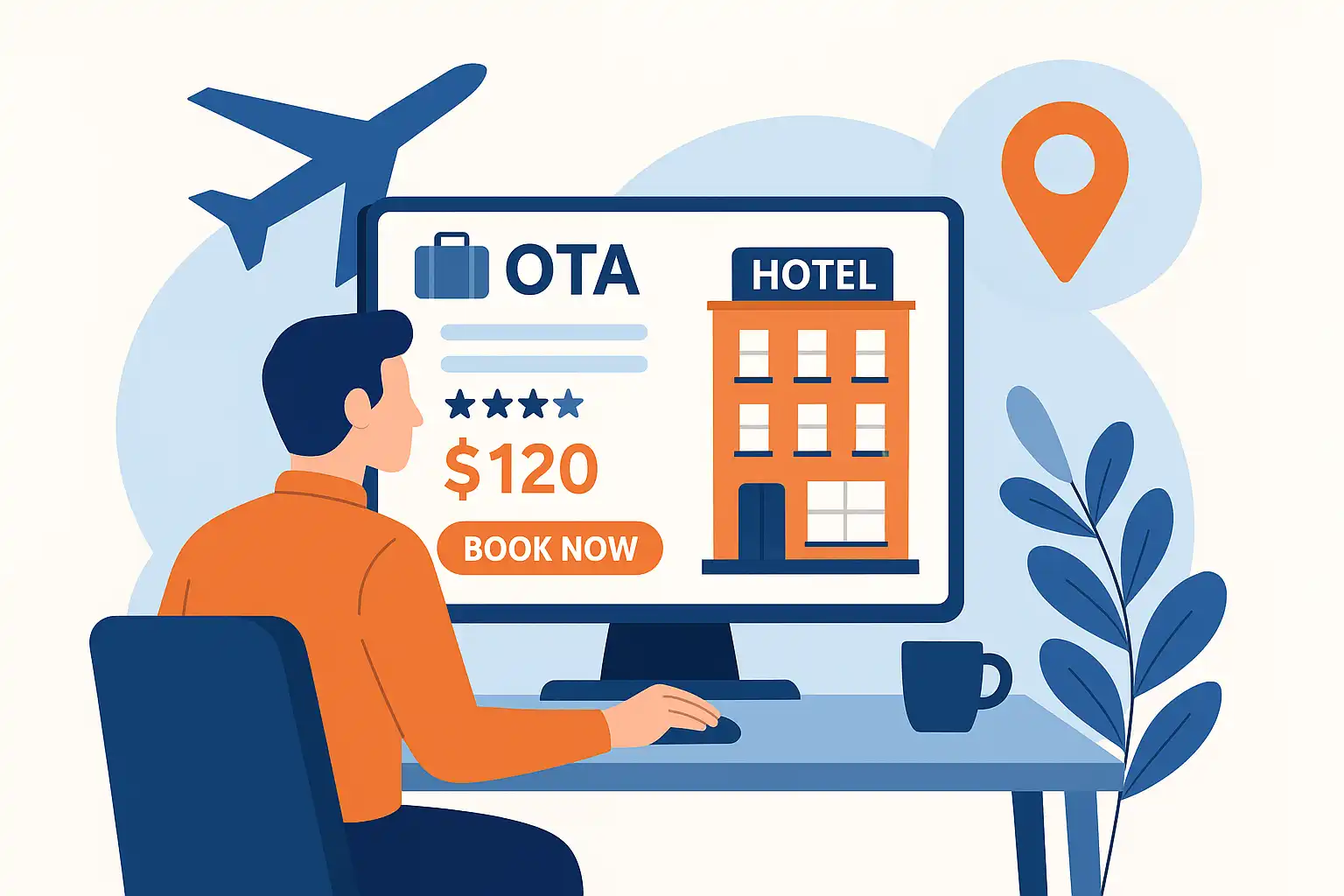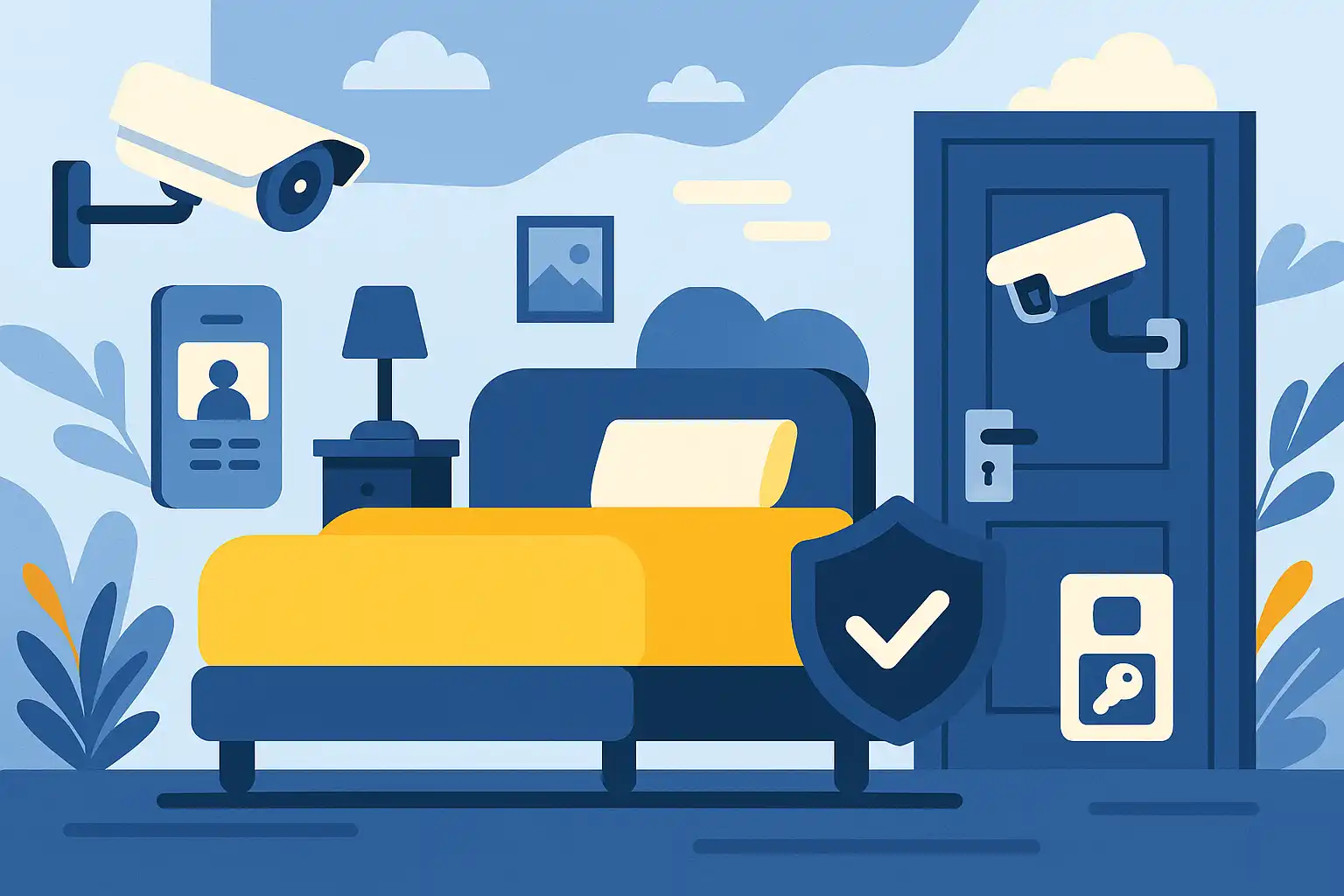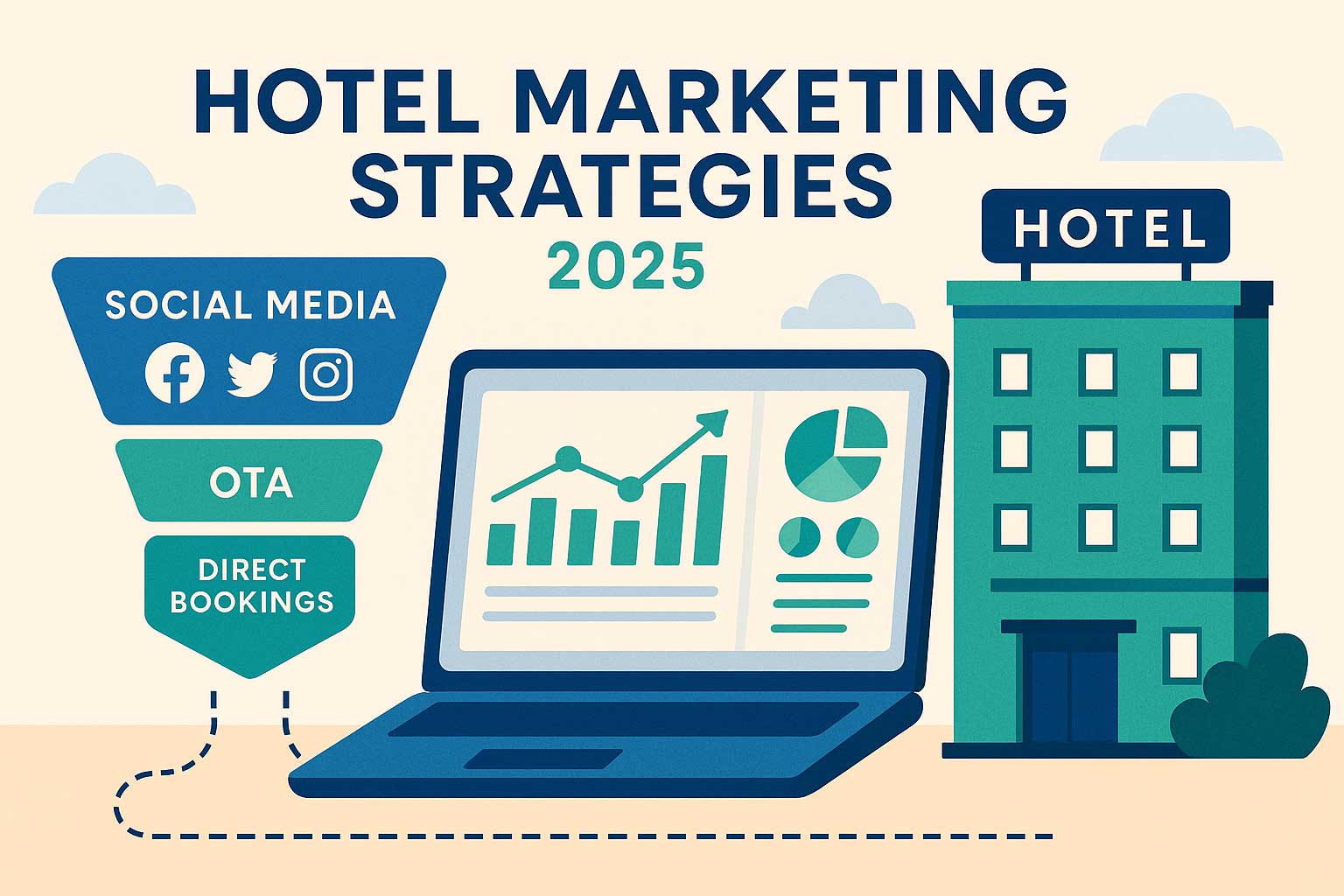14 Best Hotel KPI: Essential Metrics to Drive Performance and Revenue Growth
Aug 6, 2025
 Mika Takahashi
Mika TakahashiPopular Categories
Hotel Technology & InnovationHotel Operations OptimizationDigital MarketingIndustry TrendsRevenue ManagementHospitality Industry
Popular Categories
Trending Post

Hotel Walk Letter Template: Professional Guest Communication

Online Travel Agents: What They Are and How They Work

Hotel Security Systems: Modern Protection Solutions

Hotel Advertising: Complete Guide to Boost Bookings and Revenue

25 Hotel Marketing Strategy Ideas for 2025: Complete Guide

AI Reservation Agent: Revolutionizing Hotel Booking and Guest Experience

PMS Communication: Streamlining Property Management Through Effective Guest Messaging
Table of contents
In the fast-moving world of hospitality, relying solely on occupancy rates to gauge success just doesn’t cut it anymore. Hotel owners and managers understand that tracking a broad range of hotel KPIs offers a clearer, more complete picture of how their business is truly performing. In fact, hotels that actively monitor and act on these key performance indicators often see profitability soar by up to 15% compared to those who stick with the basics.
Think of hotel KPIs as your business’s dashboard — they offer real-time insights into everything from pricing effectiveness and operational efficiency to guest satisfaction. Whether you’re managing a charming boutique or a large hotel chain, mastering these metrics empowers you to make smarter decisions, optimize revenue, and deliver memorable guest experiences.
This guide will introduce you to the essential hotel KPIs you need to know, helping you navigate from foundational financial figures to advanced operational metrics that drive sustainable growth and success.
What are Hotel KPIs and Why They Matter
Hotel KPIs are measurable values that help professionals use as hospitality KPIs to track their progress toward goals in operations, finance, and guest experience. Think of them as diagnostic tools that highlight where things are going well and where improvements are needed, while also serving as benchmarks for future planning.
In the hotel industry, KPIs cover several important areas:
- Financial performance: Tracking how much revenue you’re generating and how profitable you are.
- Operational efficiency: Measuring how well your staff and resources are being used.
- Guest satisfaction: Gauging how happy your guests are with their stay.
- Marketing effectiveness: Understanding how well your marketing efforts bring in customers.
The real power of tracking hotel KPIs lies in the ability to spot market trends early, compare your property to competitors, and adjust your operations quickly based on data. This approach helps you maximize revenue while keeping operational costs in check.

Modern revenue management depends heavily on analyzing hospitality KPIs to fine-tune pricing and manage inventory smartly. Hotels that rely on data-driven decisions consistently outperform those that go by gut feelings or outdated methods.
The Core Financial KPIs Every Hotel Must Track
At the heart of hotel revenue management lie three interconnected KPIs: Average Daily Rate (ADR), Occupancy Rate, and Revenue Per Available Room (RevPAR). Getting a good grasp of how these work together is essential for evaluating your hotel’s financial health.
These core metrics provide quick insights into how well your pricing strategies are working, what demand looks like, and how effectively you’re optimizing revenue. Before diving into more complex figures, it’s important to master these basics.
Average Daily Rate (ADR)
Average Daily Rate tells you the average revenue earned each day for every room that’s occupied. It’s a key indicator of how effective your pricing strategy is and how your hotel is positioned in the market.
Formula: ADR = Total Room Revenue ÷ Number of Rooms Sold
For instance, if your hotel pulls in $30,000 from 150 rooms sold, your ADR is $200. This number reflects how well you’re capturing value from rooms occupied and indicates your pricing power.
To optimize your hotel’s average daily rate, consider:
- Dynamic pricing that adjusts rates based on demand and competitor prices.
- Market segmentation offering different rates for various guest types.
- Seasonal tweaks to capitalize on busy periods.
- Channel optimization to get the best rates across all booking platforms.
Keep in mind, raising your ADR without considering occupancy can backfire. If rates climb too high and occupancy drops, your overall revenue might suffer.
Occupancy Rate
Occupancy Rate shows what percentage of your available rooms are actually occupied over a certain period. It’s a window into demand strength and how well you’re utilizing your capacity.
Formula: (Occupied Rooms ÷ Available Rooms) × 100
So, if you have 150 rooms and 120 are booked, your occupancy rate is 80%. This metric helps you understand booking patterns, seasonal trends, and how effective your marketing strategies are.
Ways to boost occupancy rates include:
- Flexible pricing to attract budget-conscious guests during slow times.
- Targeted marketing campaigns aimed at specific customer groups or booking windows.
- Building partnerships with online travel agencies and corporate clients.
- Offering packages that add value without cutting into profitability.
Remember, a high occupancy rate doesn’t always mean more profit. For example, selling 95% of rooms at steep discounts might earn less than selling 75% at premium prices. That's why hospitality KPIs matter.
Revenue Per Available Room (RevPAR)
RevPAR combines ADR and occupancy to give you a complete picture of how well you’re optimizing your room revenue across all inventory.
Formula: RevPAR = ADR × Occupancy Rate OR Total Room Revenue ÷ Available Rooms
Using our earlier numbers: $200 ADR × 80% occupancy = $160 RevPAR. This figure is often considered the best single indicator of financial performance because it blends both pricing and volume success.
To make the most of RevPAR:
- Position your rates to maximize revenue without scaring off too many guests.
- Manage inventory by allocating rooms to the most profitable customer segments.
- Keep an eye on competitors to protect your market share.
- Forecast demand to adjust availability and pricing proactively.
Hotels that focus on growing RevPAR tend to achieve the healthiest financial outcomes, avoiding the pitfalls of optimizing rate or occupancy alone.
Advanced Revenue and Profitability Metrics
While the core KPIs focus on revenue, running a hotel smoothly means digging deeper into profitability, ancillary income, and operational efficiency.
These advanced metrics help you see beyond room revenue, showing the full financial picture of your hotel’s performance.
Gross Operating Profit Per Available Room (GOPPAR)
GOPPAR takes things a step further by factoring in operating expenses, giving you a clear view of actual profitability per available room.
Formula: GOPPAR = (Total Revenue - Operating Expenses) ÷ Available Rooms
Imagine your hotel makes $80,000 in gross operating profit from 100 rooms, resulting in $800 GOPPAR. This metric highlights how efficiently you’re running your operations since it accounts for costs.
GOPPAR is often more insightful than RevPAR because:
- It reveals where expenses are eating into profits.
- Shows how well you manage costs and staff productivity.
- Guides where to invest for better margins.
- Allows meaningful benchmarking against similar hotels.
Sometimes, hotels with high RevPAR but low GOPPAR discover savings in energy use, labor, or purchasing that boost their bottom line.
Total Revenue Per Available Room (TRevPAR)
TRevPAR looks at all your income sources, including food, spa, parking, and other amenities, not just room revenue.
Formula: TRevPAR = Total Revenue ÷ Number of Available Rooms
If your hotel earns an extra $15,000 from spa services, your TRevPAR will be higher than your RevPAR, showing the importance of maximizing every revenue channel.
Ways to increase TRevPAR as a hotel kpi include:
- Training staff to upsell services like dining or spa treatments.
- Creating packages that bundle rooms with amenities.
- Optimizing amenities to generate extra income.
- Cross-selling throughout the guest’s stay.
Hotels with strong TRevPAR often enjoy better overall profitability, even if their room rates are competitive.
Cost Per Occupied Room (CPOR)
CPOR as a hotel KPI measures the average cost to service each occupied room, helping you understand your pricing floor and operational efficiency.
Formula: CPOR = Total Room Operation Costs ÷ Number of Rooms Sold
For example, if your CPOR is $75, you need an ADR above $90 to maintain a 20% profit margin on room operations. This metric helps spot cost-saving opportunities.
Using CPOR, you can:
- Set minimum profitable rates.
- Identify areas to cut housekeeping or energy costs.
- Streamline operations for efficiency.
- Justify investments in automation or technology.
Knowing your CPOR prevents you from accepting bookings that look good on paper but actually lose money.
Guest Experience and Satisfaction KPIs
Happy guests are the foundation of long-term success. Hotel KPIs that measure guest satisfaction directly impact your revenue through repeat bookings, positive reviews, and stronger pricing power.
Today’s travelers often base their decisions on reviews and reputation, so tracking guest satisfaction is crucial.
Average Length of Stay (ALOS)
ALOS tracks how many nights guests stay on average, which affects operational costs and revenue per guest.
Formula: ALOS = Total Occupied Room Nights ÷ Number of Bookings
If you have 600 occupied room nights from 200 bookings, your ALOS is 3 nights. Longer stays typically mean better profitability by reducing check-in/check-out costs and boosting ancillary sales.
To encourage longer stays:
- Offer multi-night discounts.
- Partner with local attractions for extended itineraries.
- Reward loyalty program members for longer visits.
- Target business travelers with extended stay options.
Hotels with higher ALOS enjoy smoother operations and stronger guest loyalty. Use your ALOS calculator to learn more.
Customer Satisfaction Score (CSAT)
CSAT measures guest happiness through surveys, reviews, and direct feedback.
You can gather CSAT data by:
- Sending post-stay surveys with rating scales.
- Using Net Promoter Scores to gauge likelihood of recommendation.
- Monitoring online review sites.
- Collecting real-time feedback during stays.
High CSAT scores translate into:
- Greater pricing power.
- More direct bookings.
- Higher repeat business.
- Positive word-of-mouth referrals.
Hotels that consistently score well on CSAT often command 10-15% higher ADR than those with poor guest feedback.
Online Reviews and Reputation Score
With nearly all travelers consulting reviews before booking, managing your online reputation is more important than ever.
Key reputation metrics include:
- Average ratings on platforms like TripAdvisor and Google.
- Volume and frequency of reviews.
- Sentiment analysis to spot strengths and weaknesses.
- Ranking compared to local competitors.
Effective reputation management means:
- Responding promptly to reviews, both good and bad.
- Addressing issues before they escalate.
- Encouraging satisfied guests to leave feedback.
- Training staff on service aspects that influence reviews.
Hotels with strong reputations can charge 15-20% higher rates than those with poor online scores.

Marketing and Distribution KPIs
Measuring marketing effectiveness helps hotels allocate budgets wisely, improve channel performance, and reduce customer acquisition costs.
Knowing your marketing KPIs lets you balance spending with the revenue generated from different booking sources.
Direct Booking Ratio
This ratio shows what percentage of bookings come through your own channels—your website, app, or phone.
While the hotel KPI in the industry is average around 23%, top properties aim for 40-50% to cut commission fees and boost profits.
Benefits of more direct bookings include:
- Saving on OTA commissions (often 15-25%).
- Owning guest data for targeted marketing.
- Controlling rates without third-party restrictions.
- Building stronger customer relationships.
Ways to increase direct bookings:
- Offer best rate guarantees.
- Provide exclusive perks like free WiFi or breakfast.
- Optimize your website for mobile and speed.
- Run retargeting campaigns for visitors who don’t book right away.
Hotels that shift toward direct bookings often see profit margins improve by 5-10%, even if total revenue stays the same.
Website Conversion Rate
This metric tracks how well your website turns visitors into confirmed bookings.
Formula: Conversion Rate = (Completed Bookings ÷ Website Visitors) × 100
Typical hotel websites convert 2-5% of visitors, while the best achieve over 6% through optimization.
Factors that influence conversion rates include:
- Fast page loading speeds.
- Mobile-friendly design.
- Simple, transparent booking steps.
- Trust signals like security badges and guest reviews.
Even a 1% lift in conversion can significantly boost revenue without extra marketing spend.
Market Penetration Index (MPI)
MPI compares your hotel’s occupancy to the market average, showing how well you capture your share of demand.
Formula: MPI = (Hotel Occupancy % ÷ Market Occupancy %) × 100
An MPI above 100 means you’re outperforming competitors. For example, 85% occupancy against a 78% market average yields an MPI of 109, signaling strong positioning.
Use MPI to:
- Adjust pricing when you’re leading the market.
- Invest more in marketing when you’re lagging.
- Analyze competitors and market trends.
- Plan capacity and expansion.
Hotels consistently scoring over 110 on MPI often enjoy pricing power and ADR growth without losing market share.
Operational Efficiency KPIs
These internal metrics measure how well your hotel runs day-to-day, directly impacting guest satisfaction and profits.
They help identify where processes can be improved or costs cut.
Employee Satisfaction and Retention Rate
The hospitality industry faces high turnover rates—often 60-80% annually—which can be costly and disruptive.
Turnover costs include:
- Recruitment expenses.
- Training new hires (averaging $15,000-$25,000 each).
- Lost productivity during transitions.
- Negative guest experiences from inexperienced staff.
To improve retention:
- Offer competitive pay with bonuses.
- Provide career growth and training.
- Recognize outstanding work.
- Promote work-life balance to reduce burnout.
Hotels with retention above 70% typically enjoy better guest satisfaction and lower operational costs.
Sales Conversion Rate
This hotel KPI tracks how well your sales team turns inquiries into confirmed bookings, especially for groups and events.
Formula: Sales Conversion = (Confirmed Bookings ÷ Total Inquiries) × 100
Knowing which channels convert best helps focus sales efforts. Group bookings often convert at 15-25%, corporate at 30-40%.
To boost conversion:
- Respond quickly to inquiries.
- Craft compelling proposals.
- Train sales staff in consultative selling.
- Use CRM tools to track leads and follow-ups.
Hotels with strong sales conversion tend to have higher ADR for group business and more predictable revenue.

Technology Tools for KPI Tracking and Analysis
Managing hotel KPIs effectively requires integrated technology that collects, analyzes, and reports data in real time. The right tools make data-driven decisions easier and save time with automation.
Investing in KPI technology often pays off quickly through better accuracy, faster insights, and labor savings.
Property Management Systems (PMS)
A PMS is the operational hub for hospitality KPI tracking, bringing together data from all departments into dashboards.
Modern PMS features include:
- Real-time reports on occupancy, ADR, and RevPAR.
- Integration with other hotel tech platforms.
- Automated financial calculations.
- Historical data to spot trends and seasonality.
Top PMS providers like Prostay, Opera, Protel, and Mews offer cloud-based solutions for better access and less IT hassle.
Having all your data in one place lets you analyze more deeply and make faster decisions.
Revenue Management Systems (RMS)
RMS software uses demand forecasts, competitor rate tracking, and dynamic pricing to boost RevPAR and profits.
Typical RMS capabilities:
- Predicting demand from past data and market trends.
- Monitoring competitor prices.
- Recommending optimal pricing.
- Analyzing performance impacts.
Leading vendors like IDeaS and Atomize help hotels increase RevPAR by 3-8% over manual methods.
Best Practices for KPI Implementation and Monitoring
Building a strong KPI program takes planning, the right tools, and a commitment to data-driven management.
Key steps include choosing relevant metrics, setting benchmarks, and creating accountability for improvement.
Setting Up Your KPI Dashboard
A good dashboard balances detail with simplicity, showing what’s important without overwhelming users.
Design tips:
- Filter metrics by user role.
- Highlight critical data visually.
- Update in real time for urgent issues.
- Include historical trends for context.
Different teams need different views:
- General managers want a broad overview.
- Revenue managers focus on pricing and competition.
- Front desk managers track guest satisfaction and operations.
- Marketing teams monitor conversions and channels.
Review dashboards regularly—weekly for operations, monthly for strategy—to keep teams aligned.
Using KPIs for Strategic Decision Making
The true value of hotel KPIs is turning numbers into actions that improve your hotel’s performance and profits.
Effective use involves:
- Setting benchmarks from past data and industry standards.
- Watching trends to spot opportunities and risks early.
- Digging into causes when numbers stray from targets.
- Planning specific improvements based on insights.
Hotels that adjust rates during slow periods, invest in targeted marketing, or streamline operations based on KPIs often see better financial and guest satisfaction results.
Regular reviews connecting KPIs to business decisions build a culture where data guides strategy, not guesswork.
Hotels that embrace thorough KPI tracking usually see measurable improvements in revenue, efficiency, and guest happiness within six months.

Looking ahead, hotel performance management will increasingly rely on advanced analytics, artificial intelligence, and real-time adjustments driven by comprehensive KPI data. Hotels that master these tools today will secure a lasting competitive edge.
Starting with the basics—ADR, occupancy rate, and RevPAR—and gradually adding more metrics as your team and systems mature is the best path forward.
The hotels that thrive in today’s competitive market are those who use data to make faster, smarter decisions. Begin building your hospitality KPI foundation now and watch your hotel’s performance improve across every area of your business.
